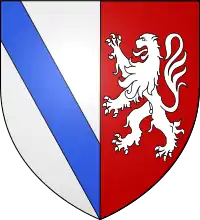Gaillard III de Durfort
Gaillard III de Durfort[lower-alpha 1] (Occitan: Galhart, Latin: Galhardus de Durefort; fl. 1414–1442[4]) was a Gascon nobleman of the Durfort family. He inherited the lordship of Duras and Blanquefort from his father, Gaillard II, in 1422.[5] In the Hundred Years' War between England and France, Gaillard took the side of the English king, who was the feudal suzerain of Gascony.[2]

In 1423, King Henry VI of England appointed Gaillard prévôt of Bayonne,[5][2] a charge he handed over to Guillaume Stone at the king's request in 1439.[6] In 1434, he served as seneschal of the Landes for the English. In 1436, he signed a contract to fight as an ally (allié) of John I, Count of Foix, and his son, Gaston IV, themselves major supporters of Henry VI.[2]
Gaillard married Indie de La Lande[lower-alpha 2] and had one son, Gaillard IV, who spent his childhood in London.[7]
Gaillard III is last mentioned in a document of 1442 and he was dead by 1444.[4]
Notes
References
- Léon Jéquier (1982), "Les armoiries de la maison de Durfort au Moyen Âge", Archivum heraldicum 96 (1–2): 7–12.
- P. L. Lewis (1964), "Decayed and Non-Feudalism in Later Medieval France", Historical Research 37 (96): 157–84. doi:10.1111/j.1468-2281.1964.tb02050.x
- Malcolm Graham Allan Vale (1970), English Gascony, 1399–1453: A Study of War, Government and Politics During the Later Stages of the Hundred Years' War (Oxford University Press), pp. 98, 175, 221, 247.
- Nicole de Peña (1977), Documents sur la maison de Durfort: XIe–XVe siècle, Part 2 (Fédération historique du Sud-Ouest), p. 1091.
- Peña (1977), p. 889.
- Jules Lépicier, ed. (1880), Archives historiques du département de la Gironde, Vol. 20 (Bordeaux), p. 95.
- Yves Durand (1975), La Maison de Durfort à l'époque moderne (Lussaud), p. 28.